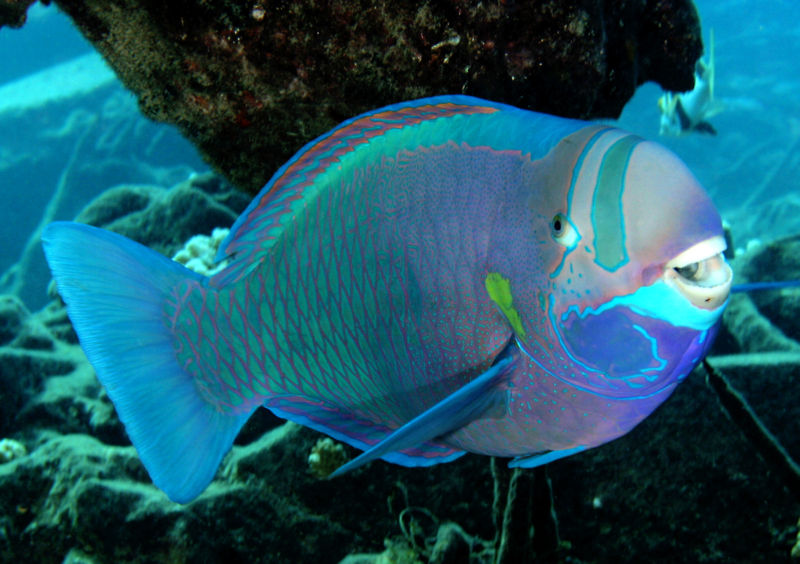[Internet blackout day entry. Expect colors.]
It occurred to us that, after making the banner, we had not done all of the creatures it featured. It's about time we fixed that; as cyan goes, the ocean sports it pretty well. The cyan in my banner, however, belongs to a parrotfish.

Parrotfish are large, colorful members of the wrasse group. Their own family, Scaridae, has several genera. They can be found in most tropical waters. There are a fair amount of different species in a variety of sizes, but they are all living acid trips. Every single one.
Parrotfish are some of the most colorful fish in the sea. They do not even have the same colors throughout their lives, even though almost every stage properly resembles an acid trip. Due to the radical ontogenic color changes that can take place, scientists once had around 350 parrotfish species on record; the actual number is somewhere around 80.
That is not the limit of the parrot fish's weirdness. Like many saltwater fish, parrot fish can change sex if the need arises.Parrot fish have a harem system - that is, one male with several females. If that one male dies, the highest female in the group starts making some rather manly hormones and steals his throne. If this sounds familiar, it's because clownfish do something similar.

Parrot fish eat coral. More specifically, the fish eats the algae inside the gooey little polyps that make up coral reefs. Those teeth up there, aside from looking like a Grateful Dead cover gone horribly wrong, are used to crunch through the calcified skeletons of the tiny cnidarians that build the reefs. The end result, by the way, is that parrot fish excrete sand. You're welcome.
Did we mention that parrotfish, although diurnal, sleep in mucous cocoons like some sort of metamorphosing alien during the night? No? All right then. Beware of the gnashing teeth in your nightmares.
It occurred to us that, after making the banner, we had not done all of the creatures it featured. It's about time we fixed that; as cyan goes, the ocean sports it pretty well. The cyan in my banner, however, belongs to a parrotfish.

Parrotfish are large, colorful members of the wrasse group. Their own family, Scaridae, has several genera. They can be found in most tropical waters. There are a fair amount of different species in a variety of sizes, but they are all living acid trips. Every single one.
Parrotfish are some of the most colorful fish in the sea. They do not even have the same colors throughout their lives, even though almost every stage properly resembles an acid trip. Due to the radical ontogenic color changes that can take place, scientists once had around 350 parrotfish species on record; the actual number is somewhere around 80.
 |
| This is a GUY. |
That is not the limit of the parrot fish's weirdness. Like many saltwater fish, parrot fish can change sex if the need arises.Parrot fish have a harem system - that is, one male with several females. If that one male dies, the highest female in the group starts making some rather manly hormones and steals his throne. If this sounds familiar, it's because clownfish do something similar.

Parrot fish eat coral. More specifically, the fish eats the algae inside the gooey little polyps that make up coral reefs. Those teeth up there, aside from looking like a Grateful Dead cover gone horribly wrong, are used to crunch through the calcified skeletons of the tiny cnidarians that build the reefs. The end result, by the way, is that parrot fish excrete sand. You're welcome.
Did we mention that parrotfish, although diurnal, sleep in mucous cocoons like some sort of metamorphosing alien during the night? No? All right then. Beware of the gnashing teeth in your nightmares.



What is your policy on someone using your photos to create paintings?
ReplyDelete